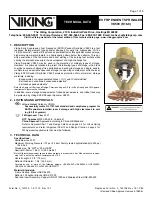
5.3.2.2 Buried Directly in Concrete Slab:
When burying an polymer joint directly in a concrete slab,
it is not necessary to wrap the joint. However, there are some additives
in concrete that could potentially damage the
fi
tting material, and in
this case, wrapping is recommended. LF brass
fi
ttings
buried directly in a concrete slab must be wrapped.
5.3.2.3 Buried in a Sub-base or Underground in Soil:
In these instances, the joint must be wrapped.
5.3.2.4 With Foaming Agents:
Foaming agents and solvents in closed-cell foam insulation kits can
damage the PPSU
fi
tting material. Therefore, it is necessary to wrap
polymer
fi
ttings in a protective tape to protect from polyurethane
foams.
5.3.3 Pressure Testing
The compression-sleeve joint is ready for immediate pressure test and
use after completion of the assembly process. There is no wait time
for the system to be put into service. See Section 7.12 for REHAU
pressure test procedures.
5.3.4 Pressure and Temperature Ratings
The maximum temperature and pressure ratings of the REHAU
residential
fi
re sprinkler system are in accordance with NFP 13D,
ASTM F877 and CSA B137.5 for SDR9 PEX, as de
fi
ned in
Section 4.4.
5.3.5 Ultraviolet Resistance
The
fi
ttings and sleeves must never be stored in direct UV or stored
outside of the original cardboard packaging. In addition, the system is
not intended for permanent outdoor applications or in areas with
continuous UV exposure.
5.3.6 Freeze Break Resistance
The
fl
exibility of RAUPEX pipe allows it to expand as water freezes in
the pipe as long as the pipe has room to expand. When the water
thaws, the pipe returns to its original shape. However, this
fl
exibility
does not ensure the integrity of the joint. If the pipe is not allowed to
expand (e.g., it is encased in concrete), it may burst.
NOTICE
Designers and installers must take precautions as per the guidelines
de
fi
ned in NFPA 13D to ensure that pipes do not freeze. Frozen pipes
may burst resulting in leaks and operational failures.
5.3.7 Chlorine Resistance
E compression-sleeve joints have a chlorine resistance
rating based on the ratings of RAUPEX pipe, as de
fi
ned in Section 4.7.
5.3.8 Stress Corrosion Resistance
LF brass
fi
ttings have been tested in accordance with
UL1821 and NSF/ANSI 14 and comply with the requirement for stress
corrosion resistance. However,
fi
ttings should not be exposed to
harmful chemicals or aggressive water conditions that could result in
operational failures.
5.3.9 Chemical Compatibility
There are certain chemicals that can damage the
compression-sleeve system. This applies to external exposure of
chemicals and to the transport of such chemicals by the piping
system.
Chemicals that may damage the compression-sleeve system include
(but are not limited to):
- Adhesives and tapes other than those recommended by REHAU
- Oil/petroleum-based products
- Paints, solvents
- Oxidizing agents (e.g., bleach)
- Disinfectants (e.g., separate dosing unit integrated into building
distribution system)
- PVC glues, solvents and cements
Fig. 5.15: DO NOT use harmful chemicals near
fi
ttings
Many factors, such as exposure time, temperature, pressure and
other operating parameters, can in
fl
uence the performance of a
system that is exposed to a chemical. To determine the impact of a
particular chemical, short- and long-term pressure testing may be
required. In some cases, a system may be resistant to short-term
exposure to the chemical, but not resistant to continuous exposure.
Each chemical must be evaluated individually. It is the responsibility of
the installing contractor to verify chemical compatibility of any
chemicals when coming into contact with the polymer material.
16
















































